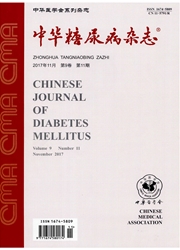

 中文摘要:
中文摘要:
目的观察雷公藤多苷对于糖尿病大鼠肝脏Toll样受体4(TLR-)介导免疫炎症信号通路的影响,探讨其对2型糖尿病脂肪性肝病的干预作用及可能机制。方法4~5周龄体重(161±9)gSD雄性大鼠75只,采用随机数字表法分为正常对照组(NC组,n=15)和高糖高脂饲料组(n=60),喂养8周后高脂大鼠尾静脉注射链脲佐菌素30mg/kg诱导2型糖尿病,分为模型对照组(DM组,n=11)、雷公藤多苷低剂量组(DM+TL组,1mg·kg^-1·d^-1,n=10)、中剂量组(DM+TM组,3mg·kg^-1·d^-1,n=13)、高剂量组(DM+TH组,6mg·kg^-1·d^-1,n=11),干预8周。检测各组大鼠生化指标,HE染色观察肝组织病理学改变。实时定量.聚合酶链反应和Western blotting检测TLR4、核因子κB(NF-κB)基因和蛋白表达,ELISA法检测血清白介素1β(IL-1β)、肿瘤坏死因子α(TNF-α)水平。各组间计量资料比较采用单因素方差分析。结果(1)病理学改变可见DM组大鼠肝细胞脂肪变性,伴炎性细胞浸润,干预组有不同程度减轻。(2)与NC组相比,DM组TLR4、NF-κBmRNA和蛋白表达明显升高(分别为7.02±1.45比1.05±0.18、8.91±1.59比1.04±0.25、2.31±0.17比1、2.84±0.38比1,t=7.157~16.540,均P〈0.05);各组大鼠肝脏TLR4、NF-κBmRNA和蛋白表达差异有统计学意义(F=12.992~60.578,均P〈0.05);各干预组较DM组呈剂量依赖性降低(t=2.264~7.223,均P〈0.05)。(3)各组大鼠血清IL-1β和TNF-α水平差异有统计学意义(F=57.717、42.992,均P〈0.05),与NC组相比,DM组明显升高(t=14.669、10.327,均P〈0.05),TM、TH组较DM组呈剂量依赖性降低(t=3.663。4.924,均P〈0.05)。结论雷公藤多苷可能通过抑制TLR4/NF—κB介导的炎症信号通路,减少炎症因子的表达,延缓2型糖尿病非酒精性脂肪性肝病的进展。
 英文摘要:
英文摘要:
Objective To investigate protective effects of tripterygium wilfordiipoly glucosidcs (TWP) on the toll like receptor 4(TLR4)-mediated immune and inflammatory signaling pathway on type 2 diabetes fatty liver disease and elucidate the possible involved mechanisms. Methods Seventy-five healthy male Spragne Dawley rats, aged 4-5 weeks and weighed (161±9) g, were divided to normal control group (NC,n=15) and high-fat diet group(n=60) by random number table method. Type 2 diabetes model was induced with 8-week high-fat diet followed by low-dose streptozocin(STZ) injection(30 mg/kg). The diabetic rats were randomly assigned to four groups: diabetes mellitus group (DM, n=11), low-dose TWP (1 mg·kg^-1·d^-1, DM+TL, n=10), medium-dose TWP(3 mg·kg^-1·d^-1,DM+TM, n=13), and high-dose TWP (6 mg·kg^-1·d^-1,DM+ TH, n=11). Treatment was given by gavage once daily for 8 weeks.We analyzed the liver histopathological change, and the gene and protein expression of TLR4 and nuclear factor-κB(NF-κB) by real time PCR and Western blotting, and the levels of serum downstream inflammatory factors interleukin 1β(IL- 1β) and tumor necrosis factor α(TNF-α) by ELISA.The significance of the data obtained was evaluated using analysis of variance (ANOVA). Results (1)Compared to the normal control group,diabetic rats were found to have obvious steatohepatitis and inflammatory cell infiltration. TWP-treated diabetic rats showed reduced hepatic inflammation in different levels. (2)TLR4 and NF-κB mRNA and protein expression in the hepatic tissue in the DM group were significantly increased, compared with those in the NC group(7.02± 1.45 vs 1.05±0.18, 8.91±1.59 vs 1.04±0.25, 2.31±0.17 vs 1, 2.84±0.38 vs 1, respectively, t=7.157-16.540, all P〈0.05). The expression of TLR4 and NF-κB mRNA and protein showed different significantly between groups (F= 12.992-60.578, P〈0.05 all above), and was decreased in TWP treatment groups in a dose-dependent man
 同期刊论文项目
同期刊论文项目
 同项目期刊论文
同项目期刊论文
 期刊信息
期刊信息
